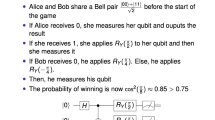Abstract
As the field of quantum computing rapidly advances, there is a growing demand for skilled professionals adept in quantum computing and programming. Recognizing this need, in this paper, we share our experiences teaching an introductory-level quantum computing course to students at Cleveland State University (CSU). The course integrates dedicated hands-on programming labs, allowing students to verify their experimental results with corresponding examples from the textbook. These labs cover a diverse range of topics, including fundamental elements such as quantum gates and circuits, quantum key distribution protocols, and quantum algorithms. As educators, our goal is to share teaching insights and resources with fellow instructors in the field. This article elucidates the rationale behind the design of each experiment, providing a deeper understanding of quantum computing.




































Similar content being viewed by others
Explore related subjects
Discover the latest articles, news and stories from top researchers in related subjects.References
Kiper J (2022) CSE 470N course syllabus. Miami University, Spring, Oxford
Bernhardt C (2020) Quantum computing for everyone. The MIT Press, Cambridge
Deutsch D (1985) Quantum theory, the Church-Turing Principle and the universal quantum computer. In: Proceedings of the Royal Society of London, Series A
Deutsch D, Jozsa R (1992) Rapid solutions of problems by quantum computation. In: Proceedings of the Royal Society of London, Series A
Mykhailova M, Svore KM (2020) Teaching quantum computing through a practical software-driven approach: experience report. In: SIGCSE’20: The 51st ACM Technical Symposium on Computer Science Education
Ernst A. An overview of Quantum Comp. Frameworks. https://www.ginkgo-analytics.com/an-overview-of-quantum-computing-frameworks/ Last accessed 21 July 2023
Cleveland Clinic. Quantum Computing. https://my.clevelandclinic.org/research/computational-life-sciences/discovery-accelerator/quantum-computing Last accessed 10 June 2023
IBM. Quantum System One. https://www.ibm.com/quantum/systems Last accessed 10 Apr 2023
Cleveland State University. News and Announcements: CSU will undertake joint interdisciplinary research and education with the Cleveland Clinic. https://www.csuohio.edu/news/ibm-quantum-system-one-debuts-clinic-joint-research-horizon Last accessed 10 Apr 2023
Qiskit. Qiskit Textbook. https://qiskit.org/learn Last accessed 10 June 2023
Qiskit. Quantum Computing Labs. https://qiskit.org/learn/course/quantum-computing-labs Last accessed 10 June 2023
Yanofsky NS, Mannucci MA (2008) Quantum computing for computer scientists. Cambridge University Press, Cambridge
Sang J, Yu C. Hands-on Quantum Programming Labs for EECS Students. https://arxiv.org/pdf/2308.14002.pdf Last accessed 29 Sept 2023
Grover LK (1996) A fast quantum mechanical algorithm for database search. In: Proceedings of the 28th Annual ACM Symposium on the Theory of Computing
Simon DR (1997) On the power of quantum computation. SIAM J Comput. https://doi.org/10.1137/S0097539796298637
Shor PW (1994) Algorithms for quantum computation: discrete logarithms and factoring. In: Proceedings of the 35th Annual Symposium on Foundations of Computer Science, IEEE Computer Society
Combarro EF, Vallecorsa S, Rodríguez-Muñiz LJ, Aguilar-González A, Ranilla J, Di Meglio A (2021) A report on teaching a series of online lectures on quantum computing from CERN. J Supercomput 77:14405–14435
Carrascal G, del Barrio A, Botella G (2021) First experiences of teaching quantum computing. J Supercomput 77:2770–2799
Salehi Ö, Seskir Z, Tepe İ (2022) A computer science-oriented approach to introduce quantum computing to a new audience. IEEE Trans Educ 65:1–8
Brilliant, https://brilliant.org/ Last accessed 09 Feb 2024
Cardetti F, Khamsemanan N, Orgnero MC (2012) Insights regarding the usefulness of partial notes in mathematics courses. J Scholarsh Teach Learn 10(1):80–92
The Jupyter Notebook. User Documentation. https://jupyter-notebook.readthedocs.io/en/stable/notebook.html Last accessed 10 June 2023
IBM Quantum. Develop quantum experiments in IBM quantum lab. https://quantum-computing.ibm.com/ Last accessed 10 June 2023
Yu N, Duan R, Ying M (2013) Five two-qubit gates are necessary for implementing the Toffoli gate. Phys Rev A 88:010304
Nation P, Paik H, Cross A, Nazario Zaira. The IBM Quantum heavy hex lattice. https://research.ibm.com/blog/heavy-hex-lattice Last accessed 10 Dec 2022
Zulehner A, Paler A, Wille R (2019) An efficient methodology for mapping quantum circuits to the IBM QX architectures. In: IEEE Transactions on Computer-Aided Design of Integrated Circuits and Systems, pp 1226–1236
Itoko T, Raymond R, Imamichi T, Matsuo A (2020) Optimization of quantum circuit mapping using gate transformation and commutation. Integration 70:43–50
Raymond R. The Simon Algorithm. https://notebook.community/antoniomezzacapo/qiskit-tutorial/community/algorithms/simon_algorithm Last accessed 22 July 2022
Johnston E, Harrigan N, Gimeno-Segovia M (2019) Programming quantum computers. O’Reilly Media Inc, Sebastopol
Danski14. Own work, CC BY-SA 3.0. https://commons.wikimedia.org/w/index.php?curid=18415805 Last accessed 10 Aug 2023
Nielsen M, Chuang I (2010) Quantum computation and quantum information. Cambridge University Press, Cambridge
Fu X, Riesebos L, Rol MA, van Straten Jeroen, van Someren J, Khammassi N, Ashraf I, Vermeulen RFL, Newsum V, Loh KKL, de Sterke JC, Vlothuizen WJ, Schouten RN, Almudever CG, DiCarlo L, Bertels K (2019) eQASM: an executable quantum instruction set architecture. In: IEEE Int’l Symposium on High Performance Computer Architectur (HPCA), pp 224–237
Matsuo A. Grover’s algorithm examples: Finding solutions to 3-SAT problems. https://github.com/Qiskit/qiskit-tutorials/blob/master/tutorials/algorithms/07_grover_examples.ipynb Last accessed 22 Dec 2022
PennyLane, https://pennylane.ai/ Last accessed 06 Feb 2024
Acknowledgements
Our work was supported in part by Dr. Galetto’s NSF Grant DMS-2200844, Dr. López’s NSF Grants DMS-2201094 and DMS-2401558, and the Cleveland Innovation District grant funded by JobsOhio, a private non-profit corporation.
Author information
Authors and Affiliations
Corresponding author
Additional information
Publisher's Note
Springer Nature remains neutral with regard to jurisdictional claims in published maps and institutional affiliations.
Rights and permissions
Springer Nature or its licensor (e.g. a society or other partner) holds exclusive rights to this article under a publishing agreement with the author(s) or other rightsholder(s); author self-archiving of the accepted manuscript version of this article is solely governed by the terms of such publishing agreement and applicable law.
About this article
Cite this article
Galetto, F., López, H.H., Rahmati, M. et al. Experience in teaching quantum computing with hands-on programming labs. J Supercomput 80, 14029–14056 (2024). https://doi.org/10.1007/s11227-024-06001-3
Accepted:
Published:
Issue Date:
DOI: https://doi.org/10.1007/s11227-024-06001-3





